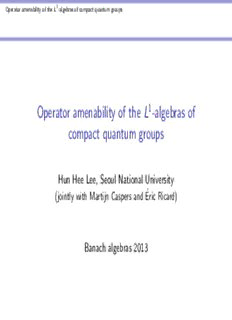
Operator amenability of the L1-algebras of compact quantum groups PDF
Preview Operator amenability of the L1-algebras of compact quantum groups
OperatoramenabilityoftheL1-algebrasofcompactquantumgroups Operator amenability of the L1-algebras of compact quantum groups Hun Hee Lee, Seoul National University (jointly with Martijn Caspers and E(cid:19)ric Ricard) Banach algebras 2013 OperatoramenabilityoftheL1-algebrasofcompactquantumgroups Amenability of L1(G) for a locally compact group G ▶ A Banach algebra A is called amenable if every bounded derivations D : A ! X(cid:3) is inner for any A-bimodule X. ▶ A locally compact group G is called amenable if there is a 1 left invariant mean on L (G) (i.e. there is a state m of L1(G) s.t. m((cid:21)(x)f) = m(f), x 2 G, f 2 L1(G), where (cid:21) : G ! B(L2(G)), (cid:21)(x)f(y) = f(x(cid:0)1y), x;y 2 G, the left regular representation of G.) ▶ (Johnson ’72) L1(G) is amenable , G is amenable. OperatoramenabilityoftheL1-algebrasofcompactquantumgroups The Fourier algebra A(G) and operator amenability ▶ Recall the group VN-alg. VN(G) = f(cid:21)(x)g′′ (cid:18) B(L2(G)). x2G ▶ The comultiplication ∆:VN(G)!VN(G (cid:2)G); (cid:21)(x)7!(cid:21)(x)(cid:10)(cid:21)(x) is a unital normal (cid:3)-isomorphism, so that A(G) = VN(G)(cid:3), the predual of VN(G) can be equipped with a Banach algebra structure given by ∆(cid:3). We call A(G) the Fourier algebra on G. ▶ Note that if we identify A(G) = ff (cid:3)g(cid:20) : f;g 2 L2(G)g, then ∆(cid:3) is nothing but the pointwise multiplication. ▶ (Ruan ’95) A(G) is operator amenable (i.e. amenable in the category of operator spaces) , G is amenable. OperatoramenabilityoftheL1-algebrasofcompactquantumgroups Extension to quantum groups ▶ (Def) A compact quantum group G is given by (A;∆), a unital C(cid:3)-algebra A = C(G) and a unital (cid:3)-isomorphism ∆ : A ! A(cid:10) A called the co-multiplication with min ▶ co-associativity (∆(cid:10)id)∆=(id (cid:10)∆)∆ ▶ cancellation law ∆(A)(A(cid:10)1)=spanf∆(a)(b(cid:10)1):a;b 2Ag and ∆(A)(1(cid:10)A) are dense in A(cid:10) A. min ▶ For a compact quantum group G = (A;∆) there is a unique Haar state h on A such that (h(cid:10)id)∆(a) = h(a)1 = (id (cid:10)h)∆(a); a 2 A: ▶ G is called Kac-type (or a Kac algebra) is h is tracial. OperatoramenabilityoftheL1-algebrasofcompactquantumgroups Extension to quantum groups: continued ▶ The reduced version C(G) of C(G) is the C(cid:3)-algebra red (cid:26)(C(G)) for the GNS representation (cid:26) of h. We de(cid:12)ne L1(G) := C(G)′′ . Then the co-multiplication red ∆ : C(G) ! C(G)(cid:10) C(G) can be naturally extended to a min unital normal (cid:3)-isomorphism ∆ : L1(G) ! L1(G)(cid:10)(cid:22)L1(G). ▶ The pre-adjoint map ∆(cid:3) : L1(G)(cid:10)bL1(G) ! L1(G), where L1(G) = L1(G)(cid:3) gives us a (completely contractive) Banach algebra structure on L1(G). ▶ Note that (L1(G);∆;h) is a VN-algebraic compact quantum group in the Kusterman-Vaes sense. OperatoramenabilityoftheL1-algebrasofcompactquantumgroups Extension to quantum groups: continued 2 ▶ Can we extend the connection between operator amenability of L1(G) and amenability of G to the quantum case? ▶ (Ruan ’96) Let G be a compact Kac algebra. Then, L1(G) is operator amenable i(cid:11) G is co-amenable (i.e. L1(G) has a bounded approximate identity (shortly BAI)). ▶ (Easy implications) G : a locally compact quantum group L1(G) is operator amenable ) G is amenable (i.e. having a left invariant mean on L1(G)) and co-amenable. ▶ (Conjecture by V. Runde) We will actually have equivalence in the above. ▶ We will answer the above conjecture in a negative way. ▶ Note that a compact quantum group G is always amenable. Actually, the Haar state does the job. OperatoramenabilityoftheL1-algebrasofcompactquantumgroups Biprojectivity and Bi(cid:13)atness ▶ A: completely contractive Banach algebra with the algebra multiplication m : A(cid:10)bA ! A: A is called operator biprojective if 9 a cb-A-bimodule map (cid:26) : A ! A(cid:10)bA such that m(cid:14)(cid:26) = idA. A is called operator bi(cid:13)at if 9 a cb-A-bimodule map (cid:18) : (A(cid:10)bA)(cid:3) ! A(cid:3) such that (cid:18)(cid:14)m(cid:3) = idA(cid:3): ▶ In the above cases (cid:26) and (cid:18) are called splitting homomorphisms. ▶ (Facts) Operator biprojectivity ) operator bi(cid:13)atness. Operator amenability , operator bi(cid:13)atness + having a BAI. OperatoramenabilityoftheL1-algebrasofcompactquantumgroups Biprojectivity and Bi(cid:13)atness: continued ▶ G : a locally compact group. (Helemskii, ’85) L1(G) is operator biprojective , G is compact. (Aristov, ’02, Wood, ’02) A(G) operator biprojective , G is discrete. ▶ L1(G) is operator bi(cid:13)at , G is amenable. (Aristov/Runde/Spronk, ’04) A(G) operator bi(cid:13)at ( G is a quasi-[SIN] group (i.e. there is a BAI (e ) in L1(G) s.t. (cid:14) (cid:3)e (cid:0)e (cid:3)(cid:14) ! 0, x 2 G), a (cid:11) x (cid:11) (cid:11) x strictly bigger class than amenable groups and discrete groups. OperatoramenabilityoftheL1-algebrasofcompactquantumgroups Biprojectivity and Bi(cid:13)atness: quantum cases ▶ (Aristov ’04, Daws ’10, Ruan/Xu ’96) Some general theory ▶ G : LCQGp with L1(G) operator biprojective ) G is compact. ▶ G : compact Kac algebra ) L1(G) is operator biprojective. ▶ L1(G) is operator biprojective with completely contractive (or completely positive) splitting hom. ) G is of Kac-type. ▶ (Question by Aristov) Is L1(G) operator biprojective for any compact quantum group G? OperatoramenabilityoftheL1-algebrasofcompactquantumgroups The main results Theorem Let G be a compact quantum group. If L1(G) is operator bi(cid:13)at, then G is of Kac type. Corollary Let G be a compact quantum group. Then, L1(G) is operator amenable if and only if G is co-amenable and of Kac type. Note that there are many examples of co-amenable compact quantum group of non-Kac type, e.g. SU (2), 0 < q < 1. q Corollary Let G be a locally compact quantum group. Then, L1(G) is operator biprojective if and only if G is compact and of Kac type.
Description: